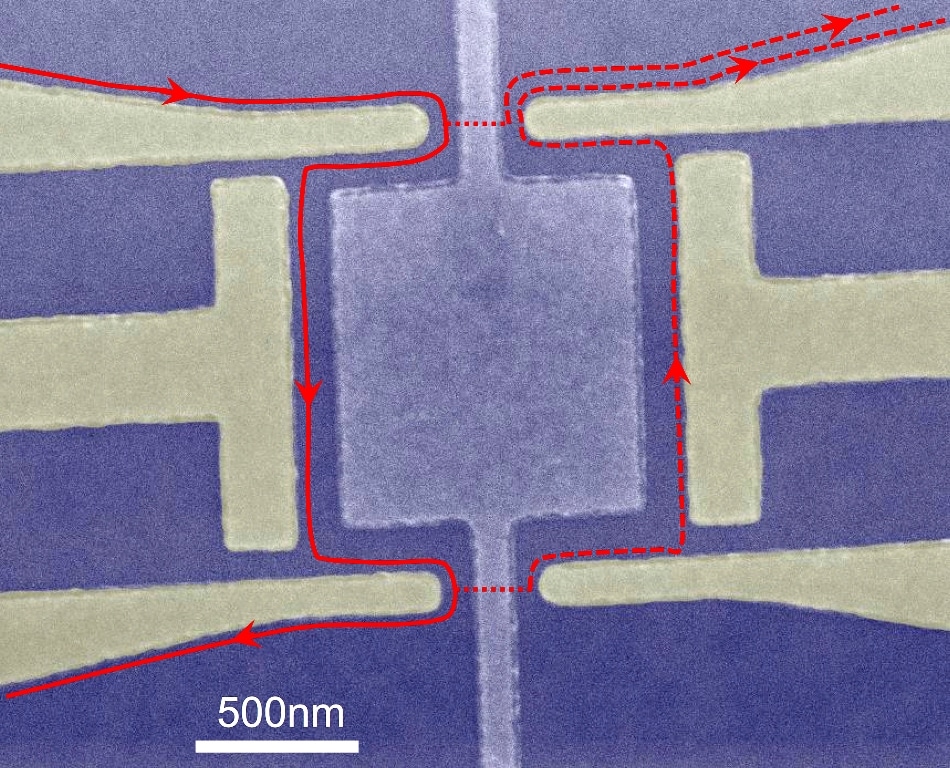Mar 5 2019
Not all qubits—the units used to encode data in quantum computing—are produced equal. Some scientists assume that topological qubits, which are more robust and less prone to environmental noise when compared to other types, may be the best medium to advance quantum computing.
 A new device created by Purdue physicists has experimentally shown quasiparticles interfering for the first time. (Image credit: Purdue University/James Nakamura)
A new device created by Purdue physicists has experimentally shown quasiparticles interfering for the first time. (Image credit: Purdue University/James Nakamura)
Quantum physics covers the interactions of fundamental particles and how they sometimes combine to produce new particles known as quasiparticles. Quasiparticles are present in fancy theoretical models; however, it has been challenging to experimentally observe and measure them. The development of a new device that enables scientists to explore interference of quasiparticles may take researchers one huge leap closer. The study outcomes were reported in Nature Physics on March 4th, 2019.
We’re able to probe these particles by making them interfere. People have been trying to do this for a long time, but there have been major technical challenges.
Michael Manfra, Bill and Dee O’Brian Chair Professor of Physics and Astronomy, Purdue University
In order to examine particles of such a small size, Manfra’s team develops small, tiny devices with the help of a crystal growth method known as molecular beam epitaxy, which involves building atomic layer by atomic layer. The devices are so tiny that they enclose electrons in two dimensions. The electrons cannot move up or down, similar to a marble moving around on the surface of a table.
In case the device, or “tabletop,” is clean and smooth enough, the individual actions of the electrons do not dominate the physics of the experiment, but the way they interact with each other dominates it. In order to reduce the individual energy of particles, Manfra’s group cooled them down to very low temperatures, approximately to −460 ○F. Furthermore, the electrons were exposed to a large magnetic field. Extremely weird physics starts to occur under the following three conditions: very cold temperatures, confined to two dimensions, and subjected to a magnetic field. Physicists refer to this as the fractional quantum Hall regime.
In these exotic conditions, electrons can arrange themselves so that the basic object looks like it carries one-third of an electron charge. We think of elementary particles as either bosons or fermions, depending on the spin of the particle, but our quasiparticles have a much more complex behavior as they evolve around each other. Determining the charge and statistical properties of these states is a long-standing challenge in quantum physics.
Michael Manfra, Bill and Dee O’Brian Chair Professor of Physics and Astronomy, Purdue University
Manfra is also a professor of materials engineering, and electrical and computer engineering.
In order to make the particles interfere, Manfra’s team developed an interferometer—a device that combines two or more quasiparticle sources to produce an interference pattern. When two stones are thrown into a pond, they form waves that intersect at some point, and it is at this point that they would create interference and the patterns would change.
However, reproducing these effects on a much smaller scale is very challenging. In such a confined space, electrons have a tendency to repel each other, therefore extra energy is needed to fit another electron into the space. This tends to muddle the interference effects, and consequently, scientists cannot observe them visibly.
The Purdue interferometer solves this problem by placing metallic plates only 25 nm away from the interfering quasiparticles. The metallic plates remove the repulsive interactions, decreasing energy cost and enabling interference to take place.
The new device has indistinguishable walls on either side and metal gates, quite similar to a pinball machine. However, in contrast to a pinball that scatters around uncontrollably, the electrons in this device stick to a very stringent pattern.
“The magic of the quantum Hall effect is that all of the current will travel on the edge of the sample, not through the middle,” said James Nakamura, a PhD candidate at Purdue and lead author of the paper. “When quasiparticles are tunneled across the beam splitter, they’re split in half, in a quantum mechanical sense. That happens twice, at two beam splitters, and interference occurs between the two different paths.”
In such a weird domain of physics, it can be challenging for scientists to identify whether they are really seeing what they believe they are seeing. However, these results reveal that potentially for the first time, scientists have viewed the quantum mechanical interference of quasiparticles.
Moreover, this mechanism could soon help in the advancement of topological qubits.
As far as we know, this is the only viable platform for trying to do more complex experiments that may, in more complicated states, be the basis of a topological qubit. We’ve been trying to build these for a while, with the end goal of validating some of these very strange properties. We’re not all the way there yet, but we have shown this is the best way forward.
Michael Manfra, Bill and Dee O’Brian Chair Professor of Physics and Astronomy, Purdue University
The Department of Energy, W. M. Keck Foundation, and Nokia Bell Labs supported this study.